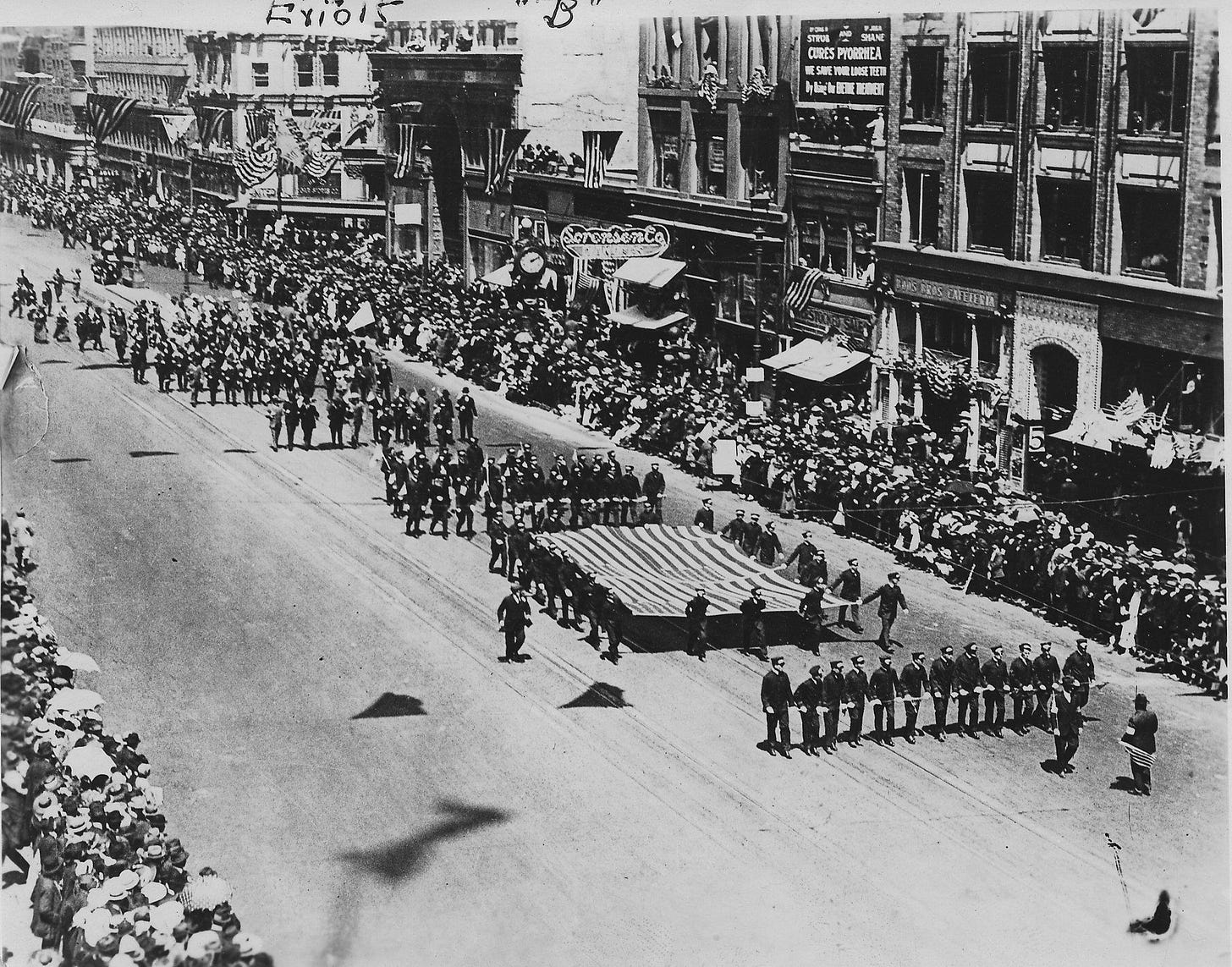On This Day in 1916: How San Francisco Buried the Truth Beneath a Bomb Blast
A city wanted justice, but what it delivered was theatre. The Preparedness Day Bombing trial was a lesson in fear, bias and power overtaking truth.
A Bomb, a City and a Lie That Lived Too Long
San Francisco, 22 July 1916. Tens of thousands lined the streets, flags waving, brass bands blaring, voices raised in patriotic chorus. The Preparedness Day Parade was a declaration of loyalty, a visual pledge that America was ready for war if it came. Then, as the procession moved down Market Street, a suitcase bomb tore through the crowd. Ten people were killed, forty more wounded. What followed was not an investigation, but a pursuit. Not of truth, but of someone convenient to blame.
This was no search for justice. It was a performance of justice, tailored to match the mood of a frightened, war-curious city. Two men were chosen as villains: Tom Mooney, a labour organiser, and Warren Billings, his associate. Their guilt was decided almost as soon as the dust settled.
How Fear Dressed Itself as Righteousness
Tom Mooney was no stranger to police attention. He had long agitated for workers’ rights, clashed with city authorities and refused to make himself small in the presence of power. In the eyes of San Francisco’s elite, he was a troublemaker, a threat. And when the bomb exploded, their suspicions had a target.
Mooney was nowhere near the blast. A photograph placed him at his home, half a mile away, with a clock in the frame showing the time. But in a city whipped into a frenzy by the attack, such details mattered little. Detectives pushed witnesses to rewrite their memories. A cattle rancher from Oregon claimed he saw Mooney pass a suitcase to Billings near the blast site. A waiter, once unsure, suddenly recognised Mooney in a police cell, encouraged by the promise of reward money. Their stories were riddled with contradictions, but they had the ring of theatre, not truth.
This was not an error. It was the result of pressure, politics and prejudice. San Francisco’s Chamber of Commerce had backed the parade. Its members wanted swift answers, not messy investigations. When the detectives came forward with suspects that fit the city's suspicion-laden imagination, few questioned it.
When Justice Bows to Applause
The courtroom was no better. Mooney’s defence offered the photograph, the timeline, the alibi. It all added up. But what counted more was the folksy charm of a lying rancher and the steely conviction of lawmen who had already made up their minds. The jury listened with open ears to everyone except the man fighting for his life. Six and a half hours of deliberation produced a guilty verdict. First-degree murder. A sentence of death.
Outside, people cheered. Inside, truth suffocated.
That was the point. No real search was made for the actual bombers. Investigations ceased the moment Mooney was convicted. It is now believed, with some weight, that the perpetrators were likely followers of the Italian anarchist Luigi Galleani, who would later be tied to a wave of bombings across the United States. But those leads were left cold. Mooney and Billings were easier to package. They ticked the right boxes. Radicals. Union men. Socialists. Dangerous in the right circles. Disposable in the wrong ones.
The idea of justice requires patience, doubt, and an appetite for uncertainty. None of those were on offer in San Francisco in July 1916.
Time Does Not Erase What Time Did Not Forgive
Tom Mooney would sit in a cell for over two decades. He aged into bitterness and poor health, a man who had lost not only his freedom but his voice in the public imagination. Over time, the lie began to unravel. Witnesses recanted. New evidence emerged. It became clear that the rancher had invented his testimony and that the waiter had been bribed to point a finger. Even President Woodrow Wilson grew uneasy with the verdict. A commission found the trial fundamentally flawed. Mooney’s death sentence was commuted, but still he sat behind bars.
Only in 1939, after 22 years, was Mooney pardoned. By then he was broken. He died three years later, at 62, a free man but not a vindicated one in the way that mattered.
His so-called accomplice, Warren Billings, was released the same year. Both men were victims of a city too eager to punish and too proud to admit its mistake. What San Francisco wanted was a clean ending. What it delivered was a long and sordid betrayal.
Why This Story Still Matters
The Preparedness Day Bombing did not change the course of World War I. America entered the conflict the following year, for reasons far removed from Market Street. But what happened in San Francisco remains a sharp example of what occurs when law and order is led by emotion rather than evidence.
History often reduces moments like these to cautionary tales. That is too soft a verdict. This was not just a miscarriage of justice. It was a deliberate contortion of it. The facts were twisted not by accident, but by design.
In every city, in every era, there will be people who rattle the foundations. Mooney was one. He challenged capital, questioned authority, demanded better from a system built to preserve power, not share it. When something terrible happened, he was already halfway to being blamed. All it took was a handful of crooked statements, a courtroom that wanted closure, and a public that had already picked its villain.
On this day, 109 years ago, a bomb exploded. Its shrapnel wounded bodies. Its aftermath wounded truth. And in that moment, a man’s life became the cost of a comfortable lie.


